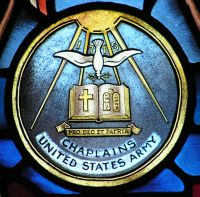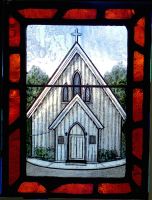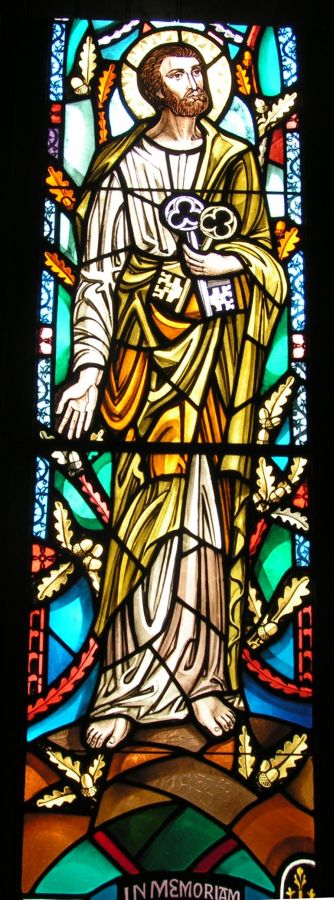left side front to rear
|
"Well Done Thou Good and Faithful Servant" In memory of Colonel Rene Edward De Russy, Superintendent of Engineering Construction here from 1838 to 1854. He served 57 years on continuous active duty as an officer after graduating from West Point in 1812. Ft. De Russy in Hawaii was named for him.
|
 Photo by Ch. David Scharff 2006 R1 |
 Photo by Ch. David Scharff 2006 R2 |
"St. Alban" In memory of Brevet Major General Emory Upton, the "boy wonder" of the Civil War. Commissioned a Second Lieutenant when he graduated from West Point in 1861, Upton successively commanded a battery of artillery, infantry regiment, infantry brigade, artillery brigade, and finally a division of cavalry. He was breveted to Brigadier General in 1864. Upton's troops captured Little Round Top at Gettysburg. At age 28 he was the Commandant of the US Military Academy. General Sherman sent him with two other officers around the world to study the armies of Europe and Asia. Upton's book The Military Policy of the United States was a penetrating look at our military policies and forces. He served as the Director of Artillery Tactics in the Artillery School here from 1877 to 1880. At age 42 he committed suicide while suffering from an incurable disease. |
|
"The Armor of God" In memory of Brevet Captain Albion Howe by his wife, Sarah McKnight Barry (daughter of Major General William F. Barry). Captain Howe was killed at Lava Beds, California, while fighting Modoc Indians. The window is one of the two oldest stained glass windows in the chapel. It is an example of enameled glass of the John Bolton school.
|
 Photo by Ch. David Scharff 2006 R3 |
 Photo by Ch. David Scharff 2006 R4 |
"Sheaf of Wheat" In memory of Caroline Matilda Barry, mother of Major General William F. Barry. The window is a companion of the Howe Window. The second of the two oldest windows in the Nave.
|
|
"Taps"
For the Centennial Celebration, Colonel Eugene Jacobs designed this window to commemorate the first playing of "Taps" for the burial of a soldier at Harrison Landing (present site of Berkley Plantation near Williamsburg on the James River). Brevet Brigadier General Daniel Butterfield, commanded the 3rd Brigade of Infantry, was an exponent of bugle calls. He was not satisfied with the final call of the day known as "Lights Out." Around 4 July 1862 he called the brigade bugler, Oliver W. Norton, to his tent and showed him some notes he had written on the back of an envelope. After getting it properly arranged, Norton was directed to play it that night. Several days later a soldier died in Captain John C. Tidball's Battery A. Rather than fire the customary three rifle volleys to honor the dead soldier, Captain Tidball instructed Oliver Norton to play "Taps." The custom of playing "Taps" at a military funeral had begun in a unit of soldiers from this fort. The picture from which the window is crafted shows a drummer boy standing beside the bugler, the grandson of the drummer boy later purchased the Berkley Plantation. (Additional remarks on Daniel Butterfield will be found elsewhere in this booklet).
|
 Photo by Ch. David Scharff 2006 R4 |
 Photo by Ch. David Scharff 2006 R6 |
"One Lord, One Faith, One Baptism"
In memory of Chaplain (Colonel) Luther Evans who had served at Ft. Monroe from 1956 to 1961 as the Staff Chaplain, Continental Army Command. The window was given by his wife and had been designed by Colonel Eugene Jacobs.
 Photo by Ch. David Scharff 2006 |
|
"Forbid Them Not"
In memory of Helen Brown Kimberly Gifford, installed by her husband Major John H. Gifford. Her father had owned one of two department stores which stood near the present Post Office. The Giffords were married in the chapel in April 1885. The window is one of the finest examples of Tiffany's use of drapery glass and lead cams working together to create the folds of the garments. The window is probably one of the last of this size that Mr. Tiffany personally worked on. |
 Photo by Ch. David Scharff 2006 R7 |
 Photo by Ch. David Scharff 2006 R8 |
"Angel Gabriel" In memory of David and Minnie French and Paul and Mary Clark, parents of Colonel and Mrs. Paul Clark, Jr. Colonel Clark had served in the Continental Army Command at Ft. Monroe from 1946 to 1959 and 1953 to 1960. |
|
"Nehemiah" To commemorate the chapel renovation, the rebuilding of the temple by Nehemiah was symbolic of the work accomplished to refurbish this lovely chapel. Note the drain pipe running from the narthex roof in the picture of the chapel in the window. Such pipes were used to fill the large cistern at the chapel around 1885-1890.
 Photo by Ch. David Scharff 2006 R9 |
 Photo by Ch. David Scharff 2006 L9 |
 Photo by Ch. David Scharff 2006 |
"St. Peter" In memory of Brigadier General Urban Niblo given by his wife and daughter. General Niblo served at Ft. Monroe as the Ordnance Officer of the Army Field Forces in 1956-57. Peter had brought Cornelius to Christ and after all the other windows had been given, one bearing his name was finally placed in the Nave. |
Historical Notes * Editor's Comments